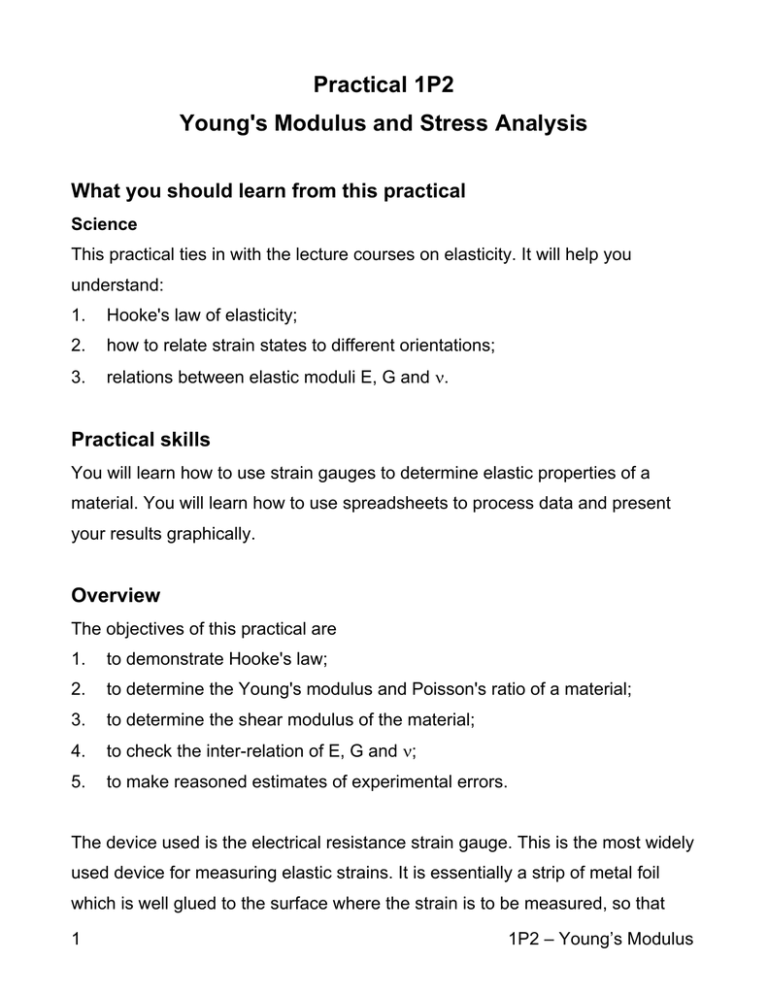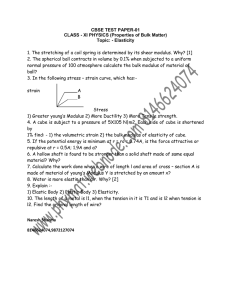Practical 1P2 Young's Modulus and Stress Analysis
advertisement

Practical 1P2 Young's Modulus and Stress Analysis What you should learn from this practical Science This practical ties in with the lecture courses on elasticity. It will help you understand: 1. Hooke's law of elasticity; 2. how to relate strain states to different orientations; 3. relations between elastic moduli E, G and ν. Practical skills You will learn how to use strain gauges to determine elastic properties of a material. You will learn how to use spreadsheets to process data and present your results graphically. Overview The objectives of this practical are 1. to demonstrate Hooke's law; 2. to determine the Young's modulus and Poisson's ratio of a material; 3. to determine the shear modulus of the material; 4. to check the inter-relation of E, G and ν; 5. to make reasoned estimates of experimental errors. The device used is the electrical resistance strain gauge. This is the most widely used device for measuring elastic strains. It is essentially a strip of metal foil which is well glued to the surface where the strain is to be measured, so that 1 1P2 – Young’s Modulus when the material is strained, the strain at the surface is fully transmitted to the metal foil. Elastic strain along the length of the strip causes a small change in resistance of the gauge, largely because of the change in length and crosssectional area of the strip, although there is also a slight change in its resistivity. Because small changes in resistance are easy to measure accurately, the gauge gives an accurate reading of the small elastic strain along the direction of the strip in the gauge. The change in resistance, and hence voltage across the strain gauge for a constant current, is proportional to the strain; the gauge manufacturer supplies the value of the constant of proportionality. For the strain gauges and current used here ε = 3.803×10-7 V, where ε = strain and V = voltage across strain gauge (measured in microvolts). Experimental details The experimental work in this practical is very simple but proper working out of the results, which should be done as much as possible during the practical period, will take some time. You should do this practical in groups of two or three, but the writing up should be done as individuals. 2 1P2 – Young’s Modulus Bending This part of the practical involves the simple cantilever bending of the beam to which the strain gauges are attached. Suspend the load pan from point “A”, and apply successively larger loads to the end of the beam. Record the strain gauge outputs produced in the x and y directions; also record the readings from the central angled gauge. Plot suitable graphs of the gauge readings as a function of the applied load (use a spreadsheet). The linearity of the graphs will demonstrate the validity of Hooke's law. Convert the strain gauge readings to strains εx and εy, and the loads to Newtons. From the εx and εy readings, the loads applied and the dimensions of the beam, calculate the Young's modulus E and Poisson's ratio ν of the beam (Use the gradients of the stress/strain lines, rather than individual readings - the LINEST function in Excel is useful here.) Make an estimate of the accuracy of your values. The theory for this part of the practical is given in appendix 1. What material do you think the beam is made of? From the εx, εy and εθ readings, work out the angle at which the central angled gauge is fixed, together with an estimate of the accuracy of your value. The theory for this part of the practical is given in appendix 2. Torsion This part of the practical involves torsion (twisting) of the beam to which the strain gauges are attached. 3 1P2 – Young’s Modulus Use the scissor-jack table to support loading eye “A” at the end of the straingauged beam, so that the beam cannot deflect downwards. Apply a load to loading eye “B”, and record the strain gauge outputs produced in the x and y directions, and from the central angled gauge. Explain the result. Now apply successively larger loads, and record the appropriate strain gauge output. Convert loads and strain gauge outputs to shear stress (see appendix 3) and shear strain. Plot the data and obtain a value of the shear modulus G = σxy/2εxy. Make an estimate of the accuracy of your value. For isotropic elastic materials, G= E 2(1 + ν ) Check the consistency of the values you have obtained with this equation. Safety considerations No unusual safety problems with this practical. Rough timetable Day 1: Introduction to practical by SD. You should be able to do most, if not all, of the experimental work. Day 2: Finish off experiments, if needed. Analyse results and begin write-up. 4 1P2 – Young’s Modulus What should be in the write up Structure of write-up Structure the report as it is normally done in a scientific paper: Background and aims, Experimental method, Results, Discussion, Conclusions. Length of write up The write-up should be about 4-5 pages maximum, plus graphs of results and diagrams. Marking considerations Appropriate length of write-up (i.e. not too long!). Coherence of argument for what is observed in each case. Not wanted in write-up More than the brief necessary details of the experimental procedure. 5 1P2 – Young’s Modulus Appendices: Elasticity theory 1. Cantilever beam theory Due to the applied force F, a couple of moment Fℓ (the bending moment) acts on the beam cross section at the gauge position. The bending stress σx varies linearly from a maximum σmax at the top surface to a minimum – σmax (compressive) at the bottom surface. Hence at a height z from the centre line of the beam, the stress σ is: σx = σ max z (h 2) This stress acts on an area = w.dz at a distance from the centre line (moment arm) = z. The total moments from all of these stresses internal to the beam must balance the moment Fℓ applied externally. 6 1P2 – Young’s Modulus Fl = ∫ force × moment arm = ∫ stress × area × moment arm σ max z w.dz z −h 2 (h 2 ) h2 = ∫ Fl = σ max 2wσ max h 2 2 ∫ z dz h −h 2 6Fl = wh 2 The tensile strain εx at the gauge position is then ε x = σ max E = 6Fl Ewh 2 The strain εy is given by: ε y = −νε x where E is Young's modulus and ν is Poisson's ratio. 2. Strain at the central angled gauge Stress and strain are not scalar or vector quantities. They are examples of second rank tensors, which describe material properties and variables that change depending on the direction one points relative to the crystal axes. You will learn more about tensor properties of materials in the second year. For the purposes of this practical it is enough to know one important result from tensor analysis, that when measuring the strain at an angle θ the result obtained is: ε θ = ε x cos 2 θ + ε y sin 2 θ + 2ε xy sin θ cos θ 7 1P2 – Young’s Modulus This equation can be used to derive θ from the readings of the three gauges, which give εθ, εx and εy. Until you apply torsion to the beam, assume that the shear strain εxy = 0. 3. Torsional loading The shear stress τ at the beam surface along the dotted line is given by τ = 8 3Fd wh 2 1P2 – Young’s Modulus Practical Questionnaire First Year: MSOM & MEM Term: Michaelmas Practical no. 1P2 Young’s Modulus 1) Was the practical timed correctly relative to the lectures ? far too early -3 -2 -1 spot on 1 2 3 far too late 2) Did you think you got out of the practical what you were meant to ? not at all 0 1 2 3 4 5 completely 5 no problem 5 very useful 3 far too long 3) Did you find writing up the practical: very difficult 0 1 2 3 4 4) Was the practical: completely useless 0 1 2 3 4 5) Was the practical: far too short -3 -2 -1 spot on 1 2 6) Was the practical: very boring 0 1 2 3 4 5 very interesting 7) Was the Junior Demonstrator completely useless 0 1 2 3 4 5 very helpful 8) Did the practical script give you enough information to do the practical ?: not enough info -3 -2 -1 spot on 1 2 3 too much / too confusing PTO 9 1P2 – Young’s Modulus Any other comments? (particularly for any problems exposed by responses to the questions above: Please hand in at the same time as your report. 10 1P2 – Young’s Modulus





